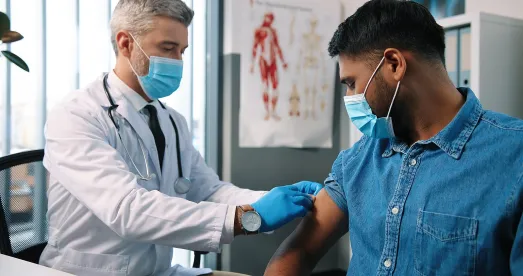Before we dive in the panel’s opinions on the stay motion, we should mention that in the Supreme Court proceedings Justice Kavanaugh gave OSHA until December 30 to respond to the various emergency motions to stay enforcement of OSHA’s ETS mandate. That is the same day that the Supreme Court gave the challengers in the CMS mandate case to respond to the Government’s own request to reinstate that mandate. Our guess is that though the Supreme Court will almost certainly decide the case before OSHA’s new January 10 compliance date, it may not do so until after the issue is fully briefed. Employers with more than 100 workers, of course, deserve an answer on this critical issue sooner rather than later. Perhaps in recognition of the practical fact that the next step is up to the Supreme Court, the Sixth Circuit has not yet issued a schedule for merits briefing.
Back to Judge Stranch’s opinion that OSHA is likely to win on the merits, which was joined by Judge Gibbons. The opinion focuses on the petitioners’ statutory attack, holding that OSHA is allowed to regulate “agents” which including anything that causes bodily harm and that the OSH Act’s objective includes exploring the “causal connections between diseases and work in environmental conditions.” Pointing to Congressional direction to pass regulations to combat HIV and other bloodborne diseases, she concludes that “OSHA necessarily has the authority to regulate infectious diseases that are not unique to the workplace.” She also holds that the “major questions” doctrine (which Judge Sutton referred to as the “clear statement” doctrine) is inapplicable because “OSHA’s issuance of the ETS is not an enormous expansion of its regulatory authority” as “OSHA has regulated workplace health and safety on a national scale since 1970, including controlling the spread of disease.” She emphasizes again that the OSH Act confers authority to protect workplace health and safety, including the transmission of viruses. She also criticizes federalism concerns are overblown because, while public health “traditionally been a primary concern of state and local officials,” the OSH Act shows that Congress decided “that the federal government would take the lead in regulating the field of occupational health.”
In response to arguments that the time for an “emergency” has passed, Judge Stranch notes that preventing a late-acting agency from correcting a problem only makes the problem worse, especially when traditional non-regulatory opinions prove inadequate. The opinion also makes short work of the claim that OSHA must make specific findings regarding every type of workplace or worker, pointing to OSHA’s demonstration that the virus spreads easily in many indoor spaces among those vulnerable and less-vulnerable such that broad measures are necessary. She also notes that the number of COVID-19 deaths in America has passed 800,000, and that working Americans have a “1-in-14 chance of hospitalization when infected”—and that OSHA estimates that the ETS will save “over 6,500 workers lives and prevent over 250,000 hospitalizations.”
The majority opinion rejects the criticisms levied by petitioners and the en banc dissenters that OSHA’s standard is over- and under-inclusive in scope. Judge Stranch responds that the “practical reality” is that OSHA’s regulations are “sufficiently expansive to ensure protection to meaningfully curb transmission rates” while avoiding burdening smaller employers. In the end, Judge Stranch finds that the ETS is good enough because it’s reasonable: “larger employers are better able to implement the policies, are at heightened risk, and regulating them will be a significant step in protecting the entire workforce from COVID-19 transmission.” The opinion spends little time on the constitutional challenges, unwilling to hold that the federal government lacks the ability to combat a pandemic and rejecting the non-delegation argument that Congress cannot authorize an agency to make such sweeping changes to American businesses.
Judge Gibbons’ concurrence states only that a court’s review of agency action is limited, so that while “[r]easonable minds may disagree on OSHA’s approach to the pandemic, but we do not substitute our judgment for that of OSHA, which has been tasked by Congress with policy-making responsibilities.” In a significant dissent, which complements Judge Sutton’s analysis, Judge Larsen disagrees with the majority’s holding that the ETS was a reasonable response to the problem, providing the following analogy: “To illustrate (without intending to trivialize) OSHA’s task, consider the danger from fire in a workplace: a pizzeria. One way to protect the workers would be to require all employees to wear oven mitts all the time—when taking phone orders, making deliveries, or pulling a pizza from the flames. That would be effective—no one would be burned—but no one could think such an approach necessary. What OSHA’s rule says is that vaccines or tests for nearly the whole American workforce will solve the problem; it does not explain why that solution is necessary.” Judge Larsen does not address the constitutional issues.




 />i
/>i

